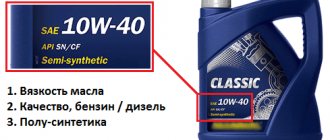Cars produced by the Volga Automobile Plant Lada Granta are equipped with two types of engines with 8 or 16 valves (2 or 4 valves per cylinder). In design, these engines are very similar and have a common “ancestor” - the 1.5-liter 2111 engine. The newest 16-valve engines have the best power ratings - up to 106 hp. The lubrication systems of all engines installed on Lada Granta cars are fundamentally the same in design. Today we will analyze in detail which engine oil to pour into the Lada Granta engine with 16 and 8 valves.
Choosing engine oil
The type of motor oil poured into the engine no longer depends on the power or number of valves, but on the operating conditions of the vehicle. The main thing, of course, is the temperature operating conditions, but the load on the engine also matters.
So, if the car is mainly operated in a temperate climate with mild, warm winters and not very hot summers, as well as with low engine loads, then the optimal use of semi-synthetic oils with viscosity classes according to SAE 10W-30 or 10W-40 (range temperatures from -20 to + 35 degrees).
It is also possible to select based on the mileage and service life of the car: if the car is less than three years old, the mileage is less than 70 thousand km and the climate conditions are moderate, then 5W-30 would be a good choice of viscosity.
Good to know: Designation of viscosity of motor oils | Engine oil viscosity index
If the car is more than three years old and/or has a mileage of more than 70 thousand km, then it is preferable to choose one with a higher viscosity - 5W-40. Such lubricants compensate for wear of engine parts and better protect them from friction. But they slightly reduce engine efficiency.
example
If negative temperatures prevail in your area most of the year and the thermometer often drops well below -30 degrees, then it is recommended to use fully synthetic with viscosity classes according to SAE 0W-30 or 0W-40 (temperature range from below –40 to + 25 degrees) . It has a low freezing point and facilitates cold engine starts. But it becomes too liquid at high temperatures and then protects the engine less well.
In hot climates, it is better to fill the engine with synthetic motor oil with a viscosity grade of SAE 20W-40 or 20W-50 (temperature range from –15 to above 45 degrees). It has good, stable performance at high temperatures.
Motor oil: What are dealers silent about?
Let's debunk the most common myths about motor oils, many of which were invented by car companies and their dealers. Myth 1. Information about the type of oil that is poured into engines on the assembly line is almost impossible to find. This is not entirely true. The type of oil used is always specified by the engine manufacturer in the service manual, but the brand is often not disclosed. The approach to informing customers about the origin of the original oil differs greatly from manufacturer to manufacturer. For the last four decades, Renault has openly recommended that all owners of their cars use ELF motor oils .
VW Group does not advertise the oil manufacturer, but does not hide it either. For example, according to lubricant experts, VW Original LL-III 5w30 oil (504/507 approval), which is filled at VW factories in Europe and Russia, is Castrol EDGE Professional LL3 5W-30. This information can be considered reliable, since it was officially confirmed by the representative office of the German automaker. However, according to other information obtained from the same sources, it could be Fuchs TITAN EM 030 VW, as well as Pentosin or Shell. And finally, there are brands that carefully hide the origin of the oil - this includes, for example, Toyota. The recommendations received from this manufacturer boil down to the need to use the original oil and not think about where and by whom it was produced. Myth 2. On for engine break-in Many large brands, and with them dealers, simply inform customers that “synthetics” are poured into the engine on the assembly line. Many car enthusiasts do not believe this and believe that cheaper mineral oil with a package of break-in additives is poured into the engine on the assembly line. The arguments include the need to change the oil during the so-called “zero maintenance”, which is carried out shortly after purchasing a car - such recommendations, for example, are given by dealers of Lada, Datsun and Hyundai. The need to change the oil soon after the car leaves the factory gates forces customers to conclude that “conveyor” oil cannot be expensive and synthetic by definition. The reason for the controversy is that dealers are introducing “zero maintenance” into the regulations on their own initiative. For them, this is a way to earn extra money. Changing the oil soon after purchase does not contradict the manufacturer's recommendations, and dealers actively use this. Meanwhile, increasing the accuracy of production of engine parts has long led to the fact that modern engines, in fact, do not need running-in, so there is no point in using “break-in” oil with a special additive package. Myth 3. Dealers don’t know what kind of oil is in their cars. This is not true. Dealers know this if only because after selling cars they are required to perform routine maintenance to maintain the factory warranty. In addition to the “original”, there is a whole list of recommended oils that can be poured into new cars of the corresponding make and model. The dealer has the right to change the supplier if this does not contradict his agreements with the manufacturer. The reason for the emergence of the myth, as often happens, was the notorious “human factor”. Often, specialists from the same dealership provide different information in response to requests. At the same time, after contacting the representative office, the client receives information that contradicts the dealer’s response. Most often, this is not malicious intent, but inconsistency in the external communication policies of dealership centers and representative offices. However, we should not forget that manufacturers may change official suppliers from time to time in order to reduce costs, and the name of the “original” motor oil may change depending on the year of manufacture of the car. Myth 4. It is better to change the engine oil as often as possible. You cannot argue with this statement, especially if the car operates in difficult conditions. But during normal operation of the car, excessive zeal in this case will only lead to additional costs, without in any way affecting the service life of the engine. As we have already figured out, the so-called “break-in oil” is a relic of the past. In the case of powerful cars, their engines are run-in on a stand under production conditions. This practice exists, for example, at the new Jaguar engine plant in Castle Bromwich. Engines of conventional cars do not require running-in. When assembled on a conveyor belt, they are filled with standard recommended motor oil (synthetic or semi-synthetic), and it must be changed according to the factory regulations, to TO-1. Most manufacturers recommend replacing after 15,000 or even 20,000 km or after 1 year of operation, whichever comes first. In the West, a service interval of 20,000 km has long become the norm, although in Russia some manufacturers (for example, Citroen, Peugeot and Toyota) have reduced it by half - to 10,000 km. In most cases, such reinsurance is not justified, but the owner of a new car cannot go against the will of the car company, since this is fraught with loss of warranty. Myth 5. You cannot change the type of oil poured into the engine. At different times, manufacturers have focused on different properties of the oil, depending on changing market requirements. In the early stages of technology development, the most important issue was maximum engine wear protection. Later the emphasis shifted to extending oil change intervals. When tightening environmental requirements became the main trend, manufacturers switched to solving this problem. Many auto companies, in pursuit of reducing fuel consumption parameters, have switched to energy-saving (friction-reducing) motor oils. This oil will not harm the engine, but if you do not want to overpay for new technologies, you can painlessly switch to a different type of oil. In this case, manufacturer tolerances play a key role. If the non-energy-saving oil you choose has the appropriate approval, you can safely use it. source Comments Tags:
What kind of oil is poured into the Lada Granta engine at the factory
Selection by API classifications - SL, SM, SN
Also, modern lubricating fluids have the following indicator - Quality level of performance properties according to API - SL, SM, SN. The latest, most modern classes SM, SN have:
- Increased oxidation resistance
- Improved protection against wear and deposits
- Also improved low temperature properties
If the car’s mileage during the season is quite high and exceeds 15,000 km, then it is advisable to change it according to the season - in winter, fill in “winter”, and in summer – “summer”. This will make the engine's work much easier. And the greater the load on the engine, the more often replacement should be carried out. Also, for vehicles operating in difficult operating conditions (mountainous terrain, dusty atmosphere, etc.), it is recommended to halve the replacement interval.
For VAZ engines, there is still a recommendation to fill synthetic and semi-synthetic motor oil only into new units with little wear. In worn engines, it is preferable to use mineral oil with a higher viscosity.
Preparing to change engine oil
A prerequisite is to warm up the car - the result from the replacement will be better. We find an inspection hole or overpass, prepare replacement oil and a new filter.
What you will need for work :
- New oil;
- Container for draining waste (at least 4 liters);
- Hexagon 12 for unscrewing the drain plug;
- Oil filter puller;
- New filter;
- If you plan to replace with flushing, use a canister of flushing oil.
Working with a lift will give full access to the drain neck and filter from below.
How to change oil on an 8 valve Grant
So, the engine is warmed up to operating temperature, the car is in the pit, the tools are at hand. How to change oil without flushing:
- Open the hood, remove the oil filler cap ;
- We climb under the car: if the crankcase is covered with protection or a factory metal sheet, we dismantle it ;
- we find the drain neck on the engine, place container under it ;
- Using a 12mm hexagon (or a 17mm wrench - depending on the type of plug) we begin to unscrew the drain plug. Please note that hot waste will flow from underneath it - at the end, sharply move your hand with the plug to the side so that it does not flood;
- After removing the plug, leave the car for 5-10 minutes so that everything is glassed;
If the car does not “eat” oil and there are no obvious leaks on the internal combustion engine, about 3 liters should drain.
We climb under the car again:
- Use a puller to unscrew the oil filter . Keep in mind that it will also leak! Not much, but it will be;
- Fill the new filter halfway and wipe it around the perimeter of the seal;
Rubbing the ring will help it fit more tightly to the attachment point.
Preparing the installation site:
- We clean the place where the filter is attached from dirt, sealant residues, etc.;
- We install it in place . As soon as it starts to spin with force, tighten it three-quarters of a turn.
When tightening the filter there is a danger of overtightening. This may cause the edge to crack and oil to leak out.
How to avoid getting caught by cantrofact
An important issue is the choice of engine oil manufacturer. The main thing here is not to buy a fake of a well-known brand. The solution may vary - some owners trust the choice of oil to the official dealers of their car manufacturer. Others go to branded stores that sell oils, and still others buy Russian oil, hoping that it will not be counterfeited. You can get acquainted with the main characteristic signs of a fake in our article - Motor oil Mobile 3000 synthetic 5w40
When purchasing, you need to pay special attention to the packaging - the canister must be neat, with even seams, the lid must be closed in a special proprietary way (different from different manufacturers), the label must be glued evenly and contain complete information about the product and its production date, down to the seconds .
What are the consequences of using counterfeit lubricant?
- Minimal - this oil burns more
- Maximum - engine life is reduced
AVTOVAZ recommends Rosneft motor oils and uses them for factory refueling on the assembly line.
Good to know: Motor oil Rosneft semi-synthetic 10w 40 reviews price
The list of brands recommended by the manufacturer also includes the following:
- MOBIL
- LUKOIL
- NOVOIL
- ESSO
- SHELL
- TNK
- TATNEFT
- G-ENERGY
- SIBIMOTOR,
- GT TURBO
You can find out reviews and characteristics of these motor oils on our portal by following the link - about motor oil.
Instructions for changing engine oil on a Grant with an 8 and 16 cl engine
So, unscrew the oil filler cap. Next, loosen the drain plug on the pan.
We place a container under it to drain the old oil and drain it until the oil begins to drip in small drops.
Next, we place the container under the oil filter and use pullers to unscrew it. For ease of replacement, we recommend disconnecting the crankshaft sensor block so as not to accidentally damage it with the puller.
If you don’t have a puller at hand, you can carefully pierce the oil filter with a screwdriver and unscrew it using the screwdriver as a lever.
After we have completely drained the old oil and unscrewed the filter, take a new filter and pour new oil into it up to about half of the filter, and also lubricate the rubber sealing ring with oil. We wrap the filter.
If you change the type of oil or fill in oil from another company, you must flush the engine with special flushing oil.
Pour new oil through the neck. With a manual transmission 3.2 liters with an automatic transmission 4.4 liters.
Let's wait a few seconds and start the engine. The oil level indicator lamp on the panel will light up. After a minute the lamp will go out. This completes the replacement process. You just need to check the level and top up if necessary.
Conclusion
In conclusion, it must be said that engine oil consumption during engine operation is normal. With a working engine, waste consumption should not exceed 1 liter per 1000 km.
When topping up, it is best to use the engine oil that has already been poured into the engine. As a last resort, you can top up with the same type and manufacturer. Mixing oils from different manufacturers is strictly prohibited, because they use different additives to the base oils, which can enter into an unwanted chemical reaction with critical consequences for the engine.
We hope our review helped answer the question that concerns you - what kind of Lada Granta engine oil is for 16 valves and for 8 valves? We ask you to share your experience on changing engine oil in a Lada Granta car under the review in the comments below.
Optimal engine oil for LADA Granta
Among the wide range of automobile oils, Mobile Super 15W-40 oil stands out. It is used both in winter and in summer, that is, all-season. It fits perfectly with diesel engines, gasoline engines and turbocharging systems, and will fit the Lada Granta engine without any problems.
By choosing this oil, the driver can forget about leaks and not worry about clogged oil lines. It will reliably protect the LADA Granta engine. The only imperfection of Mobile Super 15W-40 is considered to be the inability to use in conditions of particularly low and critical temperatures, that is, it is not suitable for the northern regions of the country. The crystallization temperature is minus 26 Celsius.
It is worth noting that a car can be accustomed to alternating motor oils, but here you need to be guided by special data that is used both in foreign countries and in our country.
What oil is better to fill in the Lada Granta engine
When purchasing a new Lada Granta, a certain amount of engine oil is already poured into the car.
VAZ-21126
- Volume 2.9 l (with manual transmission)
- Volume 4.1 l (with automatic transmission)
The Grant is equipped with engines that are exactly the same as those on the Priora and Kalina. Therefore, when choosing oil, you can be guided by the advice of these car owners.
After its service life has expired, the driver is quite often faced with the problem of choosing, namely, what kind of oil to pour into the engine and how this is done in general.
The brands of various oils poured into the engine are most often indicated in the manufacturer's recommendations. Therefore, first you need to find out what kind of oil is poured into the grant at the factory.
Oils from the following foreign manufacturers are recommended for use: all-season “Esso-Ultra” (10 W-40), “G-Energy S-Synth” (10 W-40, 15 W-40), “Shell Helix-Plus” (10 W -40), “Mobil1-ESP Formula” (5 W-30). Among domestic manufacturers, we should highlight brands that have also proven themselves to be excellent: “Rosneft-Premium” (5W-40), “Rosneft-Maximum” (5 W-40, 10 W-40), “Novoil-Super” (5 W- 30, 5 W-40, 10 W-40, 15 W-40).
Pay attention to the brand of oil poured into the engine lubrication system. It must correspond to groups SJ or SL according to the API classification and be intended for gasoline engines. Based on weather conditions and period of use, the viscosity of the oil is selected.
The very first oil change in the Lada Granta is performed after two to three thousand kilometers. Subsequent times, it is recommended to update the oil every year or after 15 thousand km.
The volume of oil in the engine is about three and a half liters. The new one is filled with a volume of 3 liters, because a minimum of 500 milliliters is intended for the engine system.
After waiting a couple of minutes after the engine starts running, check its oil level. It is necessary that the mark on the dipstick is between the “MAX” and “MIN” marks.
Also, drivers often cannot decide what kind of oil to fill in the Lada Granta, namely its type, mineral or synthetic? Synthetics are of better quality than mineral oil, but they also cost significantly more.
By improving lubrication properties, synthetic oils make it possible to increase the service life of all engine components. It is also necessary to note the cleaning properties that reduce the risk of sediment deposits as a result of engine operation, as well as residual metal particles.
Another unique advantage of this oil for our drivers is the ability to drive in winter.
Based on the above, it becomes obvious which oil is best to fill in the Lada Granta 8 valve engine. The extensive experience of Granta owners regularly proves that the engine starts much better when using synthetic oil rather than semi-synthetic and mineral oil.
The only disadvantage of this type of oil is its high price. However, if your priority is the high performance of the car, then you should not spare money.
I hope you have drawn conclusions for yourself and know for which Lada Granta model what oil is best to fill into the engine.
Finally, we draw your attention to the fact that the oil change procedure is performed alone for 10-20 minutes. Knowing what kind of oil is poured into the Lada Granta at the factory, this is not difficult to do, however, if you do this irrationally, you can be left without a guarantee.
When to change the oil
According to the manufacturer's recommendations, the engine oil must be changed after 2-3 thousand kilometers on an engine that has undergone a major overhaul or a completely new one. Then it is enough to carry out the procedure once a year, or if the car is rarely used for its intended purpose - every 15 thousand km.
Please note that when trying to save money and purchasing oil on the market, you may fall into the hands of scammers and purchase a fake. Therefore, it is better to overpay a little, but buy a obviously high-quality product that will not harm your car.
What kind of oil to fill
in the eight-valve
Lada Granta - the pros and cons of different compositions
The joyful owner of the new Lada Granta first of all needs to understand the technical fluids that are poured into the car. Therefore, we have prepared an article that will probably help you choose the average oil for the eight-valve Grant engine.











